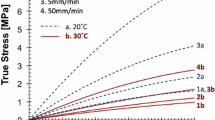Abstract
Two new materials are proposed as models for photoelasticity and photoplasticity. One is cast resin fully cured epoxy-phenol alloy which is made by the mutual cross linking of pre-condensed resins of epoxy and phenol. While epoxy-phenol alloy resin is available only for photoelasticity, the other, polycarbonate resin, is useful not only for photoelasticity, but also for photoplasticity. Polycarbonate is very tough and has large values of both photoelastic stress sensitivity and modulus of elasticity. The excellent cold workability of polycarbonate is proved by a deep-drawing test. Hence the photoplastic results obtained from a polycarbonate model can be applied by analogy to the plastic stress analysis in other ductile materials. Both resins are very transparent even in the plastic state.
Similar content being viewed by others
References
Ito, K., “On the New Materials for Freezing Three-Dimensional Photoelasticity,”Reports of Sci. Res. Inst., Vol. 30, 233–248 (1954).
Tuzi, Z., “Photoelastic Study by Riken Bakelite,”Bull. of the Inst. of Phys. & Chem. Res., Vol. 5, No. 5, 361–383 May, (1926).
Nisida, M., “On the Physical Properties of the Photoelastic Material “Phenolite”, Sci. Pap. I.P.C.R., Vol. 22, No. 467, 269–283 (Dec. 1933)
Mylonas C.: Proc. Seventh Intern. Congress of Appl. Mech., 4(1948), paper No. 14.
Ballet, M. etMallet, G., “Photóelasticimetrie-Sur l'utilisation d'une résine éthoxyline en photoelasticimetrie à trois dimensions selon la technique du figeage,”Compt. Rend., Tom., 233, 846–847 (Oct. 1951).
D'Agostino, J., Drucker, D. C., Liu, C. K., andMylonas, C., “An Analysis of Plastic Behavior of Metals with Bonded Birefringent Plastic,”Proc. Soc. Exptl. Stress Anal., Vol. 12, No. 2, 115–122 (1955).
Ito, K., “A New Simple Measuring Method for Temperature Dependence of Mechanical Behavior of High Polymer Solids,”Jour. of Sci. Res. Inst., Vol. 48, No. 1359, 154–165 (1954).
Ito, K., “Measuring Temperature Dependence of Mechanical Dependence of Mechanical Properties of Plastics,”Modern Plastics, Vol. 35, No. 3, 167–172 (Nov., 1957).
Leven, M. M., “(Fosterite)—A New Material for Three-Dimensional Photoelasticity,”Proc. Soc. Exptl. Stress Anal., Vol. 6, No. 1, 19–28 (1948).
Ito, K., “Studies on the Straining of High Polymer Solids,”J. Poly. Sci., Vol. 27, No. 115, 419–431 (Jan. 1958).
Hiltscher, R., “Spannungsoptische Untersuchung elastoplastischer Spannungszustände,”Z. VDI, Bd. 95, Nr. 23, 777–781 (Aug. 1953).
Hiltscher, R., “Theorie und Anwendung der Spannungsoptik, im elastoplastischen Gebiet,”Z. VDI, Bd. 97, Nr. 2, 49–58 (Jan 1955).
Kolsky, H., “Stress-Birefringence in Polystyrene,”Nature, Vol. 166, 235–236 (Aug. 1950).
Hetenyi, M., “A Study in Photoelasticity,” Proc. First U. S. National Congress of Appl. Mech., 499–502 (1950).
Hetenyi, M., Movie, “Yielding of Nylon Specimens”, Spring Meeting of the Soc. for Exp. Stress Analysis, Indianapolis, Indiana (1952).
Fried, B. and Shoup, N. H., “A Study in Photoplasticity: The Photoelastic Effect in the Region of Large Deformation in Polyethylene,” Proc. Second U. S. National Congress of Appl. Mech., 477–483 (1954).
Crawford, S. M., andKolsky, H., “Stress Birefringence in Polyethylene,”Proc. of the Phys. Soc., Ser. B., Vol. 64, 119–125 (Feb. 1951).
Ito, K., “Studies on Photoelastic Mechanics, (I) On the Yielding and Strain Figure of Ductile Linear Polymer Solids,”Jour. of Sci. Res. Inst., Vol. 50, No. 1417, 19–28 (1956).
Nisida, M., Hondo, M. and Hasumuma, T., “Studies of Plastic Deformation by the Photoelastic Method,” Proc. Sixth Japan National Congress for Appl. Mech., 137–140 (1956).
Mönch, E., “Die Dispersion der Doppelbrechung Bei Zelluloid als Plastizitätsmass in der Spannungsoptik,”Zeit. angew. Phys., Bd. 6, Heft 8, 371–375 (Aug. 1954).
Mönch, E. undJira, R., “Studie Zur Photoplasizität von Celluloid am Rohr under Innerdruck,”Zeit. angew. Phys., Bd., 7, Heft 9, 450–453 (Sept. 1955).
Jira, R., “Das Mechanische und Spannungsoptische Verhalten von Zelluloid bei Zweiachsiger Beanspruchung und der Nachweis seiner Eignung für ein Photoplastische Verhalten,”Konstruktion, Bd. 9, Heft 11, 438–449 (Nov. 1957).
Fukui, S., “Researches on Deep-Drawing Process,”Sci. Pap. I.P.C.R., Vol. 34, No. 849, 1422–1527 (Oct. (1938).
Ito, K., “The Plastic Working Ability Test of Sheet Plastics by a Deep Drawing Process,” Proc. Third U. S. Mat. Congress of Appl. Mech., 563–569 (1958).
Stein, R. S., Krimm, S., andTobolsky, A. V., “An Investigation of the Relationship Between Polymer Structure and Mechanical Properties,”Textile Research Journal, Vol. 19, No. 1, 8–20 (Jan. 1949).
Yuasa, K., Fukui, S., andOnishi, T., “On the Optical Creep in Photoelastic Phenomena,”Jour. of the Japan Soc. of Mechanical Engineers, Vol. 36, No. 195, 447–452 (July, 1933).
Author information
Authors and Affiliations
Rights and permissions
About this article
Cite this article
Ito, K. New model materials for photoelasticity and photoplasticity. Experimental Mechanics 2, 373–376 (1962). https://doi.org/10.1007/BF02325594
Issue Date:
DOI: https://doi.org/10.1007/BF02325594




